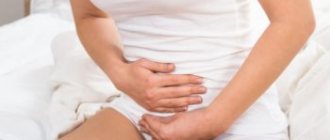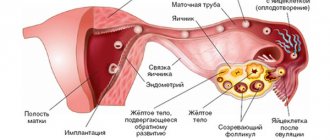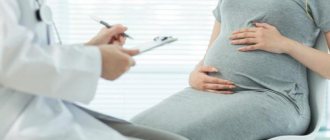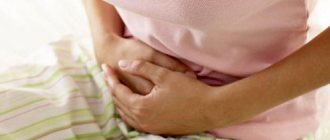Causes of illness
Spasms in the uterus can occur for several reasons. These include:
- An inflammatory process in or near an organ.
- Ovulation.
- Dysentery.
- Colic of the genitourinary system.
- Appendicitis.
- After an abortion.
- The appearance of the piriformis muscle symptom.
- Uterine fibroids.
Spasms in the uterus occur due to contraction of the muscles located in the lower abdomen, as well as when the genitourinary system is disrupted. Other causes may be painful periods or diseases of the pelvic organs. Spasms and pain of the uterus cannot be ignored and treated independently. If they occur, you must seek help from a specialist.
Sometimes, cramps in the uterus can occur in pregnant women. This occurs during spontaneous termination of pregnancy (miscarriage) and during pregnancy outside the organ (ectopic pregnancy).
Diagnosis and treatment
Cramping pain in the lower abdomen can be a symptom of a variety of pathologies, so it is very important to diagnose it correctly. Often, such pain syndrome can indicate a dangerous condition that threatens life. That is why in certain cases it is necessary to urgently call an ambulance. In particular, paroxysmal pain, the intensity of which increases over time, is considered dangerous.
It is necessary to call an ambulance in cases where spasmodic pain is accompanied by other symptoms:
- High temperature.
- Marked weakness.
- Vomiting that does not bring relief.
- Bloody discharge from the genital tract.
- Severe headache.
- Increased blood pressure.
- A sharp decrease in blood pressure.
- Fainting.
- The occurrence of abdominal asymmetry.
If an attack of cramping pain in the lower abdomen stops spontaneously, it is recommended to make an appointment with a therapist. The doctor will conduct an initial examination, collect anamnesis, and prescribe the necessary laboratory tests and instrumental examinations. Based on the results obtained, a referral to a specialist will be given to make an accurate diagnosis.
When visiting a doctor with complaints of cramping pain in the lower abdomen, the patient is referred for laboratory tests:
- general blood analysis;
- stool analysis;
- Analysis of urine.
When tests confirm that cramping pain in the lower abdomen is associated with intestinal pathologies, then other, more informative laboratory tests, which are prescribed individually, may be needed to make an accurate diagnosis.
To obtain a general picture of the condition of organs located in the abdominal or pelvic cavity, ultrasound, radiography, computed tomography or magnetic resonance imaging are used.
If there is a suspicion that cramping pain in the lower abdomen is caused by pathologies of the large intestine, a colonoscopy is performed. The procedure is complex and can sometimes be painful. Its essence lies in the fact that a probe with a video camera is inserted into the anus, which allows you to examine the surface of the large intestine along its entire length. During such a hardware examination, the doctor has the opportunity to perform a partial examination of the cecum, sigmoid, colon and rectum. Colonoscopy can be used to remove polyps and other growths. This procedure also allows tissue sampling for biopsy.
In certain cases, other studies are prescribed:
- If renal pathology is suspected, renal scintigraphy is additionally performed.
- If pathologies of the bladder occur, cystoscopy is performed. This study is performed using a special device - a cystoscope. It allows you to examine the condition of the walls of the bladder, for example, to detect the presence of ulcers or polyps.
If cramping pain occurs in the lower abdomen, then it is necessary to treat the root cause of its occurrence. To improve the patient’s well-being and relieve pain, antispasmodic drugs are used. They are prescribed by the doctor individually, taking into account the general condition of the patient and the severity of symptoms. You can also relieve pain with folk remedies, but their composition should be previously agreed with your doctor.
If pain is caused by problems with the intestines, then first of all, it is necessary to reconsider your diet and lifestyle. You can minimize the risk of pain in the lower abdomen with a gentle diet. Constipation or indigestion should not be treated solely with medications. They quickly become addictive.
To improve the functioning of the digestive system as a whole, and therefore contribute to successful treatment, it is necessary to lead an active lifestyle. It is recommended to engage in some kind of sport or regularly perform a set of therapeutic exercises.
Based on the established diagnosis, various types of treatment for cramping pain in the lower abdomen can be prescribed. Moreover, if they are caused by physiological reasons, then, most likely, conservative therapy with the use of analgesics and antispasmodics will be prescribed. In addition, if the pain is caused by physiological reasons, it will be recommended to change your lifestyle, avoid stress and nervous strain.
If cramping pain is caused by the development of cancer in the final stages, then narcotic drugs must be prescribed.
In the treatment of various inflammations of internal organs, anti-inflammatory drugs are indicated, and when infectious diseases are confirmed, antibacterial therapy is carried out. The course of medication treatment is always prescribed individually.
Endoscopic treatment is used to remove various formations on internal organs that can cause cramping pain. Using this method, cauterization is performed, small polyps are removed, bleeding is stopped, etc. Colonoscopy allows you to eliminate minor pathological formations in the large intestine.
Traditional surgical treatment is indicated only in emergency cases. For example, this may concern an acute attack of appendicitis, an ectopic pregnancy, or the presence of a malignant tumor. Surgery is indicated for cyst rupture or testicular torsion.
Physiotherapeutic methods of treatment are considered effective - ultra-high frequency therapy, electric current treatment and inductothermy, which involves the use of electromagnetic radiation.
Spasms during spontaneous termination of pregnancy
If spasms and cramping pains appear during pregnancy, this may indicate its termination. Usually they are preceded by a severe cutting pain that can radiate to the sacrum. During spasms, bloody spotting from the vagina begins. They talk about abruption of the placenta or ovum (depending on the stage of pregnancy). If you seek help at this stage, doctors will have a chance to save the fetus.
After a spontaneous miscarriage, heavy bleeding begins, which is accompanied by uterine spasms and painful sensations. The spasm will continue until you take special medications.
Spasms in the uterus during pregnancy combined with bleeding are very dangerous for the fetus. If they occur, consult a doctor immediately.
Cramping pain during pregnancy
Cramping pain during pregnancy can occur for various reasons. They are not always threatening.
Physiological causes of spastic pain in the lower abdomen during pregnancy may be associated with:
- With embryo implantation
. Very often, many women, about a week after conception, experience cramping pain in the lower abdomen. They may be accompanied by a small amount of bleeding. This sign indicates the successful attachment of the fertilized egg to the uterus. - With stretching of the uterine tissue
. In the early stages, this organ begins to change, which causes muscle spasms. In addition, paroxysmal pain in the first trimester occurs due to the fact that the uterus, increasing in size, begins to put pressure on nearby organs. This also provokes muscle spasms. - With hormonal changes
. Changes in a woman’s body can lead to disruption of the digestive process, bloating, and flatulence.
- In the early stages of pregnancy, cramping discomfort of minor intensity may occur during sexual intercourse.
- In the last months of pregnancy, paroxysmal pain occurs during training contractions. In this way, the body prepares for the upcoming birth.
Cramps during ectopic pregnancy
If spasms and pains appear that resemble contractions, this may indicate a pregnancy developing outside the organ. This occurs due to the fact that the fertilized egg did not travel to the uterus and became embedded in the fallopian tube. In this case, the woman will not have bleeding.
Such a pregnancy is rejected by the body, and a spontaneous miscarriage occurs. Spasms of the uterus and fallopian tubes gradually detach the egg from the wall. Unfortunately, sometimes the body is unable to cope on its own, and urgent surgical intervention is necessary. If this is not done, then if the fertilized egg enlarges, it may rupture the tube. The spasm of the uterus after the embryo detaches will continue until it leaves the body.
Uterine contractions and spasms can be dangerous for women of childbearing age, especially if they are at risk. These include representatives of the fair sex:
- having had a pregnancy outside the uterus;
- with tubal infertility;
- survivors of inflammatory diseases of the uterus and its appendages;
- who are taking or have taken progestin contraceptives.
Uterine spasms with algodismenorrhea
Often, a strong spasm in the uterus appears before the onset of algodismenorrhea (menstruation accompanied by pain). Spasm appears for some reason. Among these we can point out:
- Failures in metabolic processes.
- The receptors on the nerve endings are very sensitive.
- Organic pathologies of the genital organs.
- Violation of the structure of the uterus and its cervix.
- Incorrect position of the uterus.
- Malformations of the genital organs.
The causes of cramps before menstruation are not yet fully understood, and research continues.
Painful menstruation begins at a young age in people with an asthenic physique. At the same time, it is accompanied by uterine spasms. People with a labile nervous system are also susceptible to them. Sometimes it is inherited from mother to daughter. Most people who are prone to cramps during algodismenorrhea take it for granted. They do not go to the doctor and take painkillers, although the disease needs to be treated. You should consult a doctor during the onset of menstruation, after the appearance of pain and cramps.
Spasms due to uterine fibroids
Spasms and pain also occur after fibroids appear in the uterus. This happens because the organ tries to get rid of it in the same way as with an ectopic pregnancy. He actively contracts the walls in order to expel it. Fibroids appear from the wall of the uterus, usually near the cervix. This is accompanied by severe cutting pain and frequent spasms. There is also copious discharge of blood from the vagina. The pain spreads to the entire lower abdomen and can radiate to the sacrum.
In this case, there is only one way to relieve cervical spasm. To do this, it is necessary to surgically remove the fibroid. This will also relieve uterine spasms and prevent the development of complications. In order to avoid its occurrence in the future, it is necessary to regularly conduct examinations and visit a doctor.
You can independently determine the onset of the disease by certain signs. These include:
- Heavy menstruation with copious discharge.
- Spasms and pain in the lower abdomen appear periodically.
- Frequent urge to urinate begins.
- Constipation occurs.
But it happens that not all people may notice the symptoms. They are not felt by people who tolerate pain well and do not notice it.
Women who are at risk and susceptible to the manifestation of the disease should pay special attention to their health. These include women and girls:
- nulliparous at the age of about 30 years;
- having excess body weight;
- who have a hereditary predisposition;
- with hormonal imbalances in the body;
- with weakened immunity.
What diagnostics
The cause of the spasm can only be determined through a comprehensive diagnosis. Doctors select a set of necessary examinations based on the present clinical picture. Most often, women are given referrals for:
- Ultrasound;
- Analysis of urine;
- colposcopy;
- blood analysis.
Diagnosis involves ultrasound.
During ultrasound diagnostics, you can notice a change in the shape of the internal organs. This will help when searching for tumors of various types. Blood tests reveal a variety of chemical changes.
Self-diagnosis is ineffective. It is better not to hesitate, but to urgently go to the doctor to prevent dangerous consequences. It is also prohibited to independently choose medications to eliminate the symptom.
There is no need to call an ambulance if the symptom is moderate and is not accompanied by excessive bleeding. In this case, you can go to a medical facility yourself as soon as possible.
Treatment of spasms
Therapy for spasms includes the use of antispasmodic medications (for example, No-shpa, Papaverine), which relax muscles, relieve tension and restore the level of neurotransmitters. Massages and warming are also prescribed. This complex treatment does its job well and relieves uterine spasms. However, self-medication with medications is prohibited. If you experience ailments of this nature, you should immediately contact a gynecologist. He will conduct an examination and make a diagnosis, after which he will prescribe treatment. It cannot be interrupted without the doctor's permission.
What treatment
Doctors usually prescribe powerful antispasmodics. Such medications immediately eliminate the negative sign. For various neoplasms, surgical intervention is recommended.
From this video you will learn everything about pain in the lower abdomen in women:
If the symptom is moderate, measures should be taken to stabilize the state of health. First of all, you need to reconsider your diet. Follow these guidelines:
- meals should be frequent but moderate;
- limit or completely avoid seasonings, especially spicy ones;
- It is better to consume lean meats and fish;
- the diet should contain as much plant fiber as possible;
- It is forbidden to eat fatty foods until you feel better;
- soda is excluded.
If there is a sign, you need to lie down and avoid physical activity. Often this is enough to improve your well-being. After this, you will need to go to the doctor and determine the true cause of the symptom.
Source
Therapy without herbs
To do this, use massages, warming up or taking a warm bath. During the massage, blood circulation improves in the painful and spasmodic area and muscles relax. At the same time, blood circulation is restored.
Warming up or taking a warm bath can also help relax muscles, only in this case it is due to the effect of heat on the body.
Herbal therapy
There are several plants that can relieve muscle tone of the uterus and other organs.
Viburnum will help relieve uterine spasms. It has antispasmodic properties. Infusions from this plant can weaken and completely remove cramps, pain during menstruation, and also relax the nervous system.
Infusions and decoctions of ginger help improve blood circulation. Because of this, spasms are relieved.
This plant also improves blood circulation. It's very easy to find. Gruels, infusions and decoctions are prepared from it.
This is a very common and famous plant. It has antispasmodic properties and a calming effect.
This year something strange is happening to me: cramps in the uterus. It happens rarely, but accurately and mostly at night. It grabs it and doesn’t let go for about 10 minutes, then it goes away, and the whole day after that the feeling in the uterus is like during menstruation. The pain is quite severe, I already wanted to call an ambulance, since I would not have been able to drive there myself. There is no periodicity observed, I can’t relate it to anything. I'm scheduled to see a doctor on October 12, but here I'm just wondering if anyone has had this happen. I have never given birth, for about 10 years. There have never been any gynecological problems.










